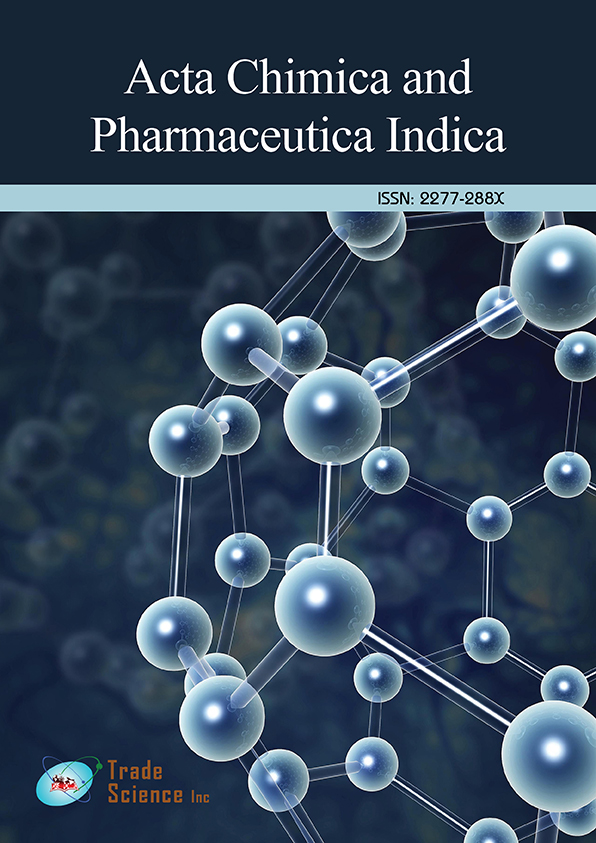Perspective
, Volume: 13( 3) DOI: 10.37532/2277-288X.2023.13(3).212Quinazoline-4(3H)-ones' Effect on Medicinal Chemistry: A Summing-Up
- *Correspondence:
- Ronald HussniDepartment of Chemistry DPP University, United States, E-mail: hussnirona4858@gmail.com
Received: August 01,2023, Manuscript No. tsacpi-24-116342; Editor Assigned: August 05,2023, Pre-QC No. tsacpi-24-116342(PQ); Reviewed: August 20,2023, QC No. tsacpi-24-116342(Q); Revised: August 25,2023, Manuscript No. tsacpi-24-116342(R); Published: August 29,2023. DOI: 10.37532/2277-288X.2023.13(3).212
Citation: Hussni R. Quinazoline-4(3H)-ones Effect on Medicinal Chemistry: A Summing-Up. Acta Chim Pharm Indica 2023;13(3):1-2.
Abstract
Quinazoline-4(3H)-ones are a class of heterocyclic compounds that have garnered significant attention in the field of medicinal chemistry due to their diverse pharmacological activities and potential therapeutic applications. This article presents an overview of the impact of quinazoline-4(3H)-ones in medicinal chemistry, highlighting their structural characteristics, biological activities, and contributions to drug discovery and development. The synthesis and modification of quinazoline-4(3H)-ones are discussed, along with their promising role in targeting various diseases. This article aims to shed light on the potential of quinazoline-4(3H)-ones as a crucial class of compounds in the ongoing pursuit of innovative medicinal agents.
Keywords
Medicinal chemistry; Pharmacological activities; Drug discovery
Introduction
Quinazoline-4(3H)-ones, a class of heterocyclic compounds, have gained prominence in medicinal chemistry due to their structural versatility and wide range of pharmacological activities. The quinazoline scaffold consists of a benzene ring fused to a pyrimidine ring, and the incorporation of a ketone group at position 4 enhances their biological activity and medicinal potential. Over the years, quinazoline-4(3H)-ones have demonstrated diverse pharmacological properties, including anticancer, antiviral, antimicrobial, antiinflammatory, and antidiabetic activities. These pharmacological attributes have propelled the exploration of quinazoline-4(3H)-ones as promising candidates for the development of novel therapeutic agents.
Quinazoline-4(3H)-ones possess a flexible structure that allows for chemical modifications, enabling researchers to tailor their properties and enhance their potency and selectivity. The versatile nature of quinazoline-4(3H)-ones has made them attractive targets for medicinal chemists engaged in drug discovery programs. This article aims to provide an overview of the effect of quinazoline4(3H)-ones in medicinal chemistry, focusing on their synthesis, biological activities, and potential applications in drug development.
The synthesis of quinazoline-4(3H)-ones involves various methodologies, including cyclization reactions and condensation processes. Cyclization reactions often utilize urea derivatives and appropriate reagents to form the quinazoline ring system. Additionally, the introduction of diverse substituents at different positions of the quinazoline-4(3H)-one scaffold allows for the modulation of their biological activities and pharmacokinetic properties. Structural modification of quinazoline-4(3H)-ones has been a focal point to improve their drug-like characteristics and therapeutic potential.
Quinazoline-4(3H)-ones have exhibited a wide spectrum of pharmacological activities, making them attractive candidates for therapeutic interventions. Studies have reported their anticancer properties, with potential applications in targeting various signaling pathways involved in tumorigenesis. Furthermore, quinazoline-4(3H)-ones have shown antiviral activity against certain viral strains, indicating their potential in antiviral drug development. Their antimicrobial, anti-inflammatory, and antidiabetic properties highlight their multifaceted therapeutic potential.
Conclusion
Quinazoline-4(3H)-ones represent a significant class of heterocyclic compounds with remarkable potential in medicinal chemistry. Their diverse pharmacological activities, synthesis flexibility, and modifiability make them promising candidates for drug discovery and development. The ongoing research in this field is expected to further elucidate the therapeutic potential of quinazoline-4(3H)-ones and pave the way for the design and development of novel drugs targeting a multitude of diseases. Continued efforts in understanding the structure-activity relationships and mechanisms of action of quinazoline-4(3H)-ones will undoubtedly contribute to their optimal utilization in medicinal chemistry and in addressing current and emerging healthcare challenges.
